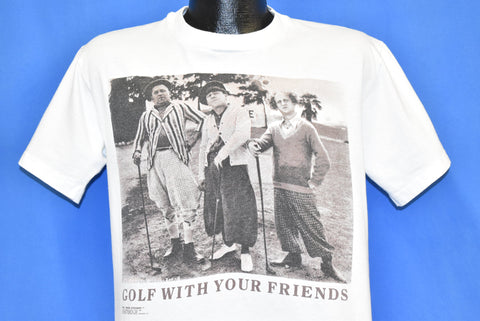Throughout history, comedy has been a powerful tool to combat tragedy. Arguably one of the most influential comedy institutions in the history of Hollywood are the Three Stooges, the vaudeville comedy act. The antics of Moe, Curly, and Larry have been rewatched and retold since their short films debuted in the 1930s. But even at the peak of their career, the actors were not as widely celebrated as they are today. Their kitsch-cult following has amassed throughout the decades of their popularity.
Appearing in almost 200 shorts and feature films from early 30s to the early 70s, the Stooges most famous trio was Moe, Curly, and Larry. The role of Curly was originally filled by his brother Shemp, and later other actors. Moe, the leader of the pack, was distinguished his crisp bowl-cut, Curly, a true brawny knucklehead, and Larry, the wacky-haired intermediary.
All three of the original actors grew up in blue-collar Jewish families living in Brooklyn, New York. Moses and Shemp Howard had dreams of being in showbusiness, following the likes of Charlie Chaplin and the Marx Brothers, working-class Jewish men making a name for themselves in Hollywood. They performed in burlesque shows and teamed up for the first time in 1916, performing a blackface routine. This act would continue until 1922, when they caught the attention of comedian Ted Healy.
Philadelphia-based musician and comedian Larry Fine was brought into the act and the Stooges were born. Healy became their mentor, but he was an erratic alcoholic, known to abuse his co-stars. Healy came up with the Stooges’ signature slapstick comedy style, all the while stiffing them out of their share of the proceeds. While under Healy’s contract, they were billed as “Ted Healy & His Stooges.” They would star in a film for Fox Studios, where it was clear that Healy didn’t have the “star-factor,” but the Stooges sure did.
The short films starring Larry Curly and Moe showcased the Stooges at the peak of their slapstick humor and physical farce comedy, released from 1935 and 1941. These shorts would even get more attention than the features they were accompanying. The Stooges were making a killing for Columbia Pictures, boosting the studio’s fortunes exponentially-- but the actors were kept on a one-year contract throughout their career at the studio and kept in the dark about how much the studio was making off of them. Like many people in Hollywood, they feared Cohn’s mob connections, and after their upbringing had been happy to take the amount they were given.
But by the early 40s, Curly’s health was deteriorating, as the years of taking heavy blows during their act began to take their toll. Also a heavy drinker, Curly was forced to keep working through serious injury and illness. At the age of 42, he suffered a stroke. He went back to work within a month, and had a paralyzing stroke a year later.
Cohn saw their act as unsophisticated, and the actors as interchangeable. But their chemistry was utterly unique. After endless auditions for a new Stooge, Shemp Howard was brought back into the group. Many enjoyed his new energy after years of an ill Curly, while others were unable to see him outside of Curly’s shadow. In 1952 Curly died, and three years later Shemp had a heart attack at age 60.
Moe and Larry kept the act alive, now joined by Joe Besser as the third Stooge. But the success of their routing was ebbing. By 1957 television was taking over the market and Columbia was the only studio still producing shorts. But in ‘58, a major comeback was on the horizon. Curly-era shorts were picked up for TV broadcast by a number of networks across the United States. They were an instant hit among kids and families.
Once again, the Stooges were in high demand. Moe and Larry revisited the act with Joe DeRita. From ‘59 to 1965 they made a series of new films, recorded for a Stooges cartoon series, and shot a pilot for a TV show. But in 1970 Larry suffered a stroke that ended his career, and four years later died at the age of 72. Moe was determined to continue on with the Stooges act, but he was diagnosed with terminal lung cancer and passed away not long after.
The lasting cultural influence of the Stooges was felt even during the peak of their commercial success. In the early 1940s, their influence was so vast that it was deemed a potential threat to The Third Reich, and the Stooges were put on Hitler’s personal death list. Their shorts often criticized class disparity after the Great Depression, and satirized Axis leaders at a time when the U.S. was still neutral in WWII.
In the two-part film “You Nazsty Spy!” the Stooges portray Hitler and his fascist regime ruthlessly, predating Chaplin’s infamous “The Great Dictator.” The film was also produced in defiance of the Hays Code, a set of moral guidelines used for major production studios that censored American cinema for decades.

References to the comedy trio remain everywhere in American culture, including the punk band The Stooges. Rumor has it that Moe and Larry were happy to share the Stooges name with the band, so long as they could go to their shows for free.
Their shorts are now available colorized and in high-def. The first thing that comes to mind is usually their stupidity or reckless behavior, but they are also important figures in broadcasting anti-fascist commentary to a major audience at a time when not many others were brave enough to do it.



